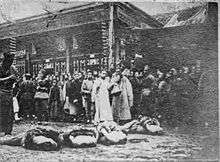Decapitation
Decapitation, also known as beheading, is the total separation of the head from the body. Such an injury is invariably fatal to humans and most other animals, since it deprives the brain of oxygenated blood, while all other organs are deprived of the involuntary functions that are needed for the body to function.
| Decapitation | |
|---|---|
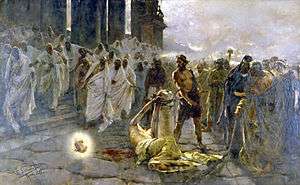 | |
| The Beheading of Saint Paul. Painting by Enrique Simonet in 1887, Malaga Cathedral |

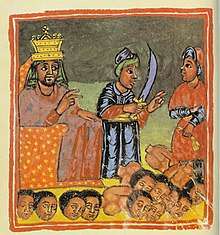
The term beheading refers to the act of deliberately decapitating a person, either as a means of murder or as an execution; it may be accomplished with an axe, a sword, a knife, a machete or by mechanical means such as a guillotine or chainsaw. An executioner who carries out executions by beheading is sometimes called a headsman.[1] Accidental decapitation can be the result of an explosion,[2] a car or industrial accident,[note 1] improperly administered execution by hanging or other violent injury. Suicide by decapitation is rare but not unknown.[3] The national laws of Saudi Arabia, Yemen, and Qatar permit beheading; however, in practice, Saudi Arabia is the only country that continues to behead its offenders regularly as a punishment for crime.[4]
Less commonly, decapitation can also refer to the removal of the head from a body that is already dead. This might be done to take the head as a trophy, for public display, to make the deceased more difficult to identify, for cryonics, or for other, more esoteric reasons.[5][6]
Etymology
The word decapitation has its roots in the Late Latin word decapitare. The meaning of the word decapitare can be discerned from its morphemes de- (down, from) + capit- (head).[7] The past participle of decapitare is decapitatus[8] which was used to create decapitationem, the noun form of decapitatus in Medieval Latin. From the Medieval Latin form, decapitationem, the French word décapitation was produced.[8]
History
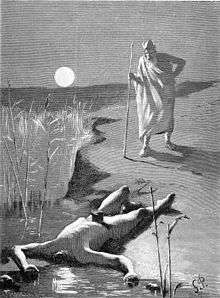
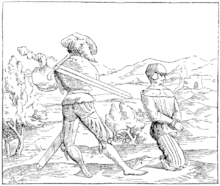
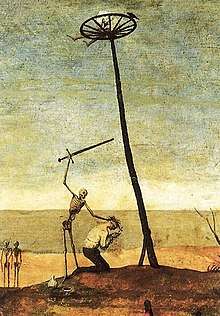
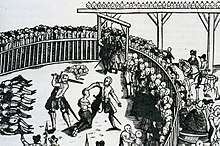
Humans have practiced capital punishment by beheading for millennia. The Narmer Palette (c. 3000 BCE) shows the first known depiction of decapitated corpses. The terms "capital offence", "capital crime", "capital punishment", derive from the Latin caput, "head", referring to the punishment for serious offences involving the forfeiture of the head; i.e. death by beheading.[9]
Some cultures, such as ancient Rome and Greece regarded decapitation as the most honorable form of death.[10] Many European nations continued to reserve the method only for nobles and royalty. In France, the French Revolution made it the only legal method of execution for all criminals regardless of class, one of the period's many symbolic changes.[10]
Others have regarded beheading as dishonorable and contemptuous, such as the Japanese troops who beheaded prisoners during World War II.[10] In recent times, it has become associated with terrorism.[10]
Physiological aspects
Pain
If the headsman's axe or sword was sharp and his aim was precise, decapitation was quick and was presumed to be a relatively painless form of death. If the instrument was blunt or the executioner was clumsy, multiple strokes might be required to sever the head, resulting in a prolonged and more painful death. The person to be executed was therefore advised to give a gold coin to the headsman to ensure that he did his job with care. Robert Devereux, 2nd Earl of Essex,[11] and Mary, Queen of Scots[12] required three strikes at their respective executions. The same could be said for the execution of Johann Friedrich Struensee, favorite of the Danish queen Caroline Matilda of Great Britain. Margaret Pole, 8th Countess of Salisbury, is said to have required up to 10 strokes before decapitation was achieved.[13] This particular story may, however, be apocryphal (since highly divergent accounts exist). Historian and philosopher David Hume, for example, relates the following about her death:[14]
She refused to lay her head on the block, or submit to a sentence where she had received no trial. She told the executioner, that if he would have her head, he must win it the best way he could: and thus, shaking her venerable grey locks, she ran about the scaffold; and the executioner followed her with his ax, aiming many fruitless blows at her neck before he was able to give the fatal stroke.

To ensure that the blow would be fatal, executioners' swords usually were blade-heavy two-handed swords. Likewise, if an axe was used, it almost invariably was wielded with both hands. In England a bearded axe was used for beheading, with the blade's edge extending downwards from the tip of the shaft.
Finland's official beheading axe resides today at the Museum of Crime in Vantaa. It is a broad-bladed two-handed axe. It was last used when murderer Tahvo Putkonen was executed in 1825, the last execution in peacetime in Finland.[15]
Physiology of death by decapitation
Decapitation is quickly fatal to humans and most animals. Unconsciousness occurs within 10 seconds without circulating oxygenated blood (brain ischemia). Cell death and irreversible brain damage occurs after 3–6 minutes with no oxygen, due to excitotoxicity. Some anecdotes suggest more extended persistence of human consciousness after decapitation,[16] but most doctors consider this unlikely and consider such accounts to be misapprehensions of reflexive twitching rather than deliberate movement, since deprivation of oxygen must cause nearly immediate coma and death ("[Consciousness is] probably lost within 2–3 seconds, due to a rapid fall of intracranial perfusion of blood").[17]
A laboratory study testing for humane methods of euthanasia in awake animals used EEG monitoring to measure the time duration following decapitation for rats to become fully unconscious, unable to perceive distress and pain. It was estimated that this point was reached within 3–4 seconds, correlating closely with results found in other studies on rodents (2.7 seconds, and 3–6 seconds).[18][19][20] The same study also suggested that the massive wave which can be recorded by EEG monitoring approximately one minute after decapitation ultimately reflects brain death. Other studies indicate that electrical activity in the brain has been demonstrated to persist for 13 to 14 seconds following decapitation (although it is disputed as to whether such activity implies that pain is perceived),[21] and a 2010 study reported that decapitation of rats generated responses in EEG indices over a period of 10 seconds that have been linked to nociception across a number of different species of animals, including rats.[22]
Some animals (such as cockroaches) can survive decapitation, and die not because of the loss of the head directly, but rather because of starvation.[23] A number of other animals, including chickens, snakes, and turtles, have also been known to survive for some time after being decapitated, as they have a slower metabolism, and their nervous systems can continue to function at some capacity for a limited time even after connection to the brain is lost, responding to any nearby stimulus.[24][25][26]
Although head transplantation by the reattachment of blood vessels has been successful with animals,[27] a fully functional reattachment of a severed human head (including repair of the spinal cord, muscles, and other critically important tissues) has not yet been achieved.
Technology
Guillotine

Early versions of the guillotine included the Halifax Gibbet, which was used in Halifax, England, from 1286 until the 17th century, and the "Maiden", employed in Edinburgh from the 16th through the 18th centuries.
The modern form of the guillotine was invented shortly before the French Revolution with the aim of creating a quick and painless method of execution requiring little skill on the part of the operator. Decapitation by guillotine became a common mechanically assisted form of execution.
The French observed a strict code of etiquette surrounding such executions. For example, a man named Legros, one of the assistants at the execution of Charlotte Corday, was imprisoned for three months and dismissed for slapping the face of the victim after the blade had fallen in order to see whether any flicker of life remained.[28] The guillotine was used in France during the French Revolution and remained the normal judicial method in both peacetime and wartime into the 1970s, although the firing squad was used in certain cases. France abolished the death penalty in 1981.
The guillotine was also used in Algeria before the French relinquished control of it, as shown in Gillo Pontecorvo's film The Battle of Algiers.
Another guillotine existed in Vatican City until recent years. It had been brought in by Napoleon's forces during the early 19th century; and, as of 1870, the pope still claimed the authority to use it. The Holy See has since abolished capital punishment within its own jurisdiction, and recent popes have condemned capital punishment wherever it is still practised.
German Fallbeil

Many German states had used a guillotine-like device known as a Fallbeil ("falling axe") since the 17th and 18th centuries, and decapitation by guillotine was the usual means of execution in Germany until the abolition of the death penalty in West Germany in 1949. It was last used in communist East Germany in 1966.
In Nazi Germany, the Fallbeil was reserved for common criminals and people convicted of political crimes, including treason. Members of the White Rose resistance movement, a group of students in Munich that included siblings Sophie and Hans Scholl, were executed by decapitation.
Contrary to popular myth, executions were generally not conducted face up, and chief executioner Johann Reichhart was insistent on maintaining "professional" protocol throughout the era, having administered the death penalty during the earlier Weimar Republic. Nonetheless, it is estimated that some 16,500 persons were guillotined in Germany and Austria between 1933 and 1945, a number that includes resistance fighters both within Germany itself and in countries occupied by Nazi forces. As these resistance fighters were not part of any regular army, they were considered common criminals and were in many cases transported to Germany for execution. Decapitation was considered a "dishonorable" death, in contrast to execution by firing squad.
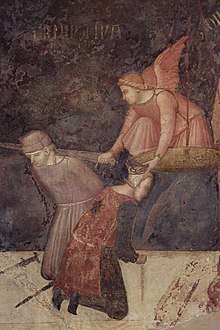
Historical practices by nation
Africa
Congo
In the Democratic Republic of Congo, the conflict and ethnic massacre between local army and Kamuina Nsapu rebels has caused several deaths and atrocities such as rape and mutilation. One of them is decapitation, both a fearsome way to intimidate victims as well as an act that may include ritualistic elements. According to an UN report from Congolese refugees, they believed the Bana Mura and Kamuina Nsapu militias have "magical powers" as a result of drinking the blood of decapitated victims, making them invincible.[29] According to some reports, they indeed feed the blood from their victims' heads to younger members as baptism rite, then they often burn the remains into the fire or sometimes they consume the human remains, committing cannibalism.[30]
Besides the massive decapitations (like the beheading of 40 members of the State Police), a notorious case of worldwide impact happened in March 2017 to Swedish politician Zaida Catalán and American UN expert Michael Sharp, who were kidnapped and executed during a mission near the village Ngombe in the Kasai Province. The UN was reportedly horrified when video footage of the execution of the two experts surfaced in April that same year, where some grisly details led to assume ritual components of the beheading: the perpetrators proceeded to cut the hair of both victims first, and then one of them beheaded Catalan only, because it would "increase his power",[31] which may be linked to the fact that Congolese militians are particularly brutal in their acts of violence toward women and children.[32]
In the trial that followed the investigation after the bodies were discovered, and according to a testimony of a primary school teacher from Bunkonde, near the village of Moyo Musuila where the execution took place, he witnessed a teenage militant carrying the young woman's head,[33] but despite the efforts of the investigation, the head was never found. According to a report published on 29 May 2019, the Monusco peacekeeping military mission led by Colonel Luis Mangini, in the search for the missing remains, arrived to a ritual place in Moyo Musila where "parts of bodies, hands and heads" were cut and used for rituals,[34] where they lost the track of the victim's head.
Asia
Azerbaijan
Kyaram Sloyan was killed during the 2016 Armenian–Azerbaijani clashes and beheaded by soldiers of Azerbaijani Armed Forces, with videos and pictures of his severed head posted on social media networks.[35][36][37][38]
China
In traditional China, decapitation was considered a more severe form of punishment than strangulation, although strangulation caused more prolonged suffering. This was because in Confucian tradition, bodies were gifts from their parents, and so it was therefore disrespectful to their ancestors to return their bodies to the grave dismembered. The Chinese however had other punishments, such as dismembering the body into multiple pieces (similar to the English quartering). In addition, there was also a practice of cutting the body at the waist, which was a common method of execution before being abolished in the early Qing dynasty due to the lingering death it caused. In some tales, people did not die immediately after decapitation.[39][40][41][42]
India
The British officer John Masters recorded in his autobiography that Pathans in British India during the Anglo-Afghan Wars would behead enemy soldiers who were captured, such as British and Sikh soldiers.[43][44][45][46]
Japan
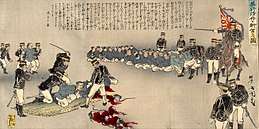
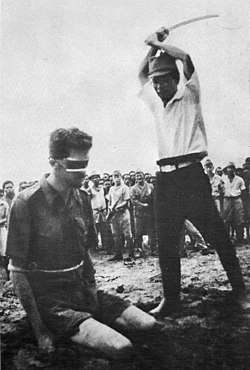
In Japan, decapitation was a common punishment, sometimes for minor offences. Samurai were often allowed to decapitate soldiers who had fled from battle, as it was considered cowardly. Decapitation was historically performed as the second step in seppuku (ritual suicide by disembowelment). After the victim had sliced his own abdomen open, another warrior would strike his head off from behind with a katana to hasten death and to reduce the suffering. The blow was expected to be precise enough to leave intact a small strip of skin at the front of the neck—to spare invited and honored guests the indelicacy of witnessing a severed head rolling about, or towards them; such an occurrence would have been considered inelegant and in bad taste. The sword was expected to be used upon the slightest sign that the practitioner might yield to pain and cry out—avoiding dishonor to him and to all partaking in the privilege of observing an honorable demise. As skill was involved, only the most trusted warrior was honored by taking part. In the late Sengoku period, decapitation was performed as soon as the person chosen to carry out seppuku had made the slightest wound to his abdomen.
Decapitation (without seppuku) was also considered a very severe and degrading form of punishment. One of the most brutal decapitations was that of Sugitani Zenjubō (杉谷善住坊), who attempted to assassinate Oda Nobunaga, a prominent daimyō, in 1570. After being caught, Zenjubō was buried alive in the ground with only his head out, and the head was slowly sawn off with a bamboo saw by passers-by for several days (punishment by sawing; nokogiribiki (鋸挽き).[47] These unusual punishments were abolished in the early Meiji era. This scene is described in the last page of James Clavell's book Shōgun.
Korea
Historically, decapitation had been the most common method of execution in Korea, until it was replaced by hanging in 1896. Professional executioners were called mangnani (망나니) and they were volunteered from death-rows.
Pakistan
Pakistan's government employs death by hanging for capital punishment. Since 2007, militants from Tehrek-e-Taliban Pakistan have used beheadings as a form of punishment for opponents, criminals and spies in the north west region of Pakistan. Severed heads of opponents or government officials in Swat were left on popular street corners in order to terrorize local population. The beheadings have stopped in Swat since the military incursion and sweep-up that began in May 2009 and ended in June 2009. Three Sikhs were beheaded by the Taliban in Pakistan in 2010. Daniel Pearl was beheaded by his captors in the city of Karachi.
Despite official condemnation from the state itself,[48] such beheading continues to flourish in the Taliban strongholds of Baluchistan and Khyber-Pakhtunkhwa.
Thailand
Historically, decapitation had been the main method of execution in Thailand, until it was replaced by shooting in 1934.
Europe
Bosnia and Herzegovina
During the war in Bosnia and Herzegovina (1992–1995) there were a number of ritual beheadings of Serbs and Croats who were taken as prisoners of war by mujahedin members of the Bosnian Army. At least one case is documented and proven in court by the ICTY where mujahedin, members of 3rd Corps of Army BiH, beheaded Bosnian Serb Dragan Popović.[49][50]
Britain
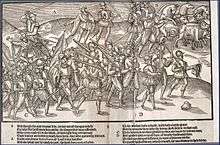
The British Empire used beheading and display of severed heads and other body parts on pikes, etc., as a method to support conquest, territorial expansion, pillage and looting. Heads were displayed to terrify various peoples into submission, such as enslaved Africans and Chinese.[51][52]
Historically, beheading was typically used for noblemen, while commoners would be hanged; eventually, hanging was adopted as the standard means of non-military executions. The last actual execution by beheading was of Simon Fraser, 11th Lord Lovat on 9 April 1747, while a number of convicts (typically traitors sentenced to drawing and quartering, a method which had already been discontinued) were beheaded posthumously up to the early 19th century. Beheading was degraded to a secondary means of execution, including for treason, with the abolition of drawing and quartering in 1870 and finally abolished by the Statute Law (Repeals) Act 1973.
Celts
The Celts of western Europe long pursued a "cult of the severed head", as evidenced by both Classical literary descriptions and archaeological contexts.[53] This cult played a central role in their temples and religious practices and earned them a reputation as head hunters among the Mediterranean peoples. Diodorus Siculus, in his 1st-century Historical Library (5.29.4) had this to say about Celtic head-hunting:
They cut off the heads of enemies slain in battle and attach them to the necks of their horses. The blood-stained spoils they hand over to their attendants and striking up a paean and singing a song of victory; and they nail up these first fruits upon their houses, just as do those who lay low wild animals in certain kinds of hunting. They embalm in cedar oil the heads of the most distinguished enemies, and preserve them carefully in a chest, and display them with pride to strangers, saying that for this head one of their ancestors, or his father, or the man himself, refused the offer of a large sum of money. They say that some of them boast that they refused the weight of the head in gold.
Both the Greeks and Romans found the Celtic decapitation practices shocking and the latter put an end to them when Celtic regions came under their control. However, Greeks and Romans both employed decapitation and other horrific tortures, highlighting a tendency to view practices as more shocking when carried out by an outside group, even if the practices are essentially similar.[54]
According to Paul Jacobsthal, "Amongst the Celts the human head was venerated above all else, since the head was to the Celt the soul, centre of the emotions as well as of life itself, a symbol of divinity and of the powers of the other-world."[55] Arguments for a Celtic cult of the severed head include the many sculptured representations of severed heads in La Tène carvings, and the surviving Celtic mythology, which is full of stories of the severed heads of heroes and the saints who carry their own severed heads, right down to Sir Gawain and the Green Knight, where the Green Knight picks up his own severed head after Gawain has struck it off, just as St. Denis carried his head to the top of Montmartre.
A further example of this regeneration after beheading lies in the tales of Connemara's St. Feichin, who after being beheaded by Viking pirates carried his head to the Holy Well on Omey Island and on dipping the head into the well placed it back upon his neck and was restored to full health.
Classical antiquity
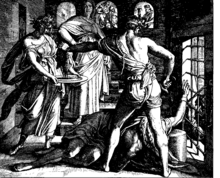
They slew the noblest Romans of their time.
The helpless victims they decapitated,
An act of infamy with shame related.
One head was Pompey's, who brought triumphs home,
The other Cicero's, the voice of Rome.
— Martial, Epigram I:60 (Trans. by Garry Wills)
The ancient Greeks and Romans regarded decapitation as a comparatively honorable form of execution for criminals. The traditional procedure, however, included first being tied to a stake and whipped with rods. Axes were used by the Romans, and later swords, which were considered a more honorable instrument of death. Those who could verify that they were Roman citizens were to be beheaded, rather than undergoing the much more horrific experience of crucifixion. In the Roman Republic of the early 1st century BC, it became the tradition for the severed heads of public enemies—such as the political opponents of Marius and Sulla, for example—to be publicly displayed on the Rostra in the Forum Romanum after execution. Perhaps the most famous such victim was Cicero who, on instructions from Mark Antony, had his hands (which had penned the Philippicae against Antony) and his head cut off and nailed up for display in this manner.
France
In France, until the abolition of capital punishment in 1981, the main method of execution had been by beheading by means of the guillotine. Other than a small number of military cases where a firing squad was used (including that of Jean Bastien-Thiry) the guillotine was the only legal method of execution from 1791, when it was introduced by the Legislative Assembly during the last days of the kingdom French Revolution, until 1981. Before the revolution, beheading had typically been reserved to noblemen and carried out manually. In 1981, President François Mitterrand abolished capital punishment and issued commutations for those whose sentences had not been executed.
The first person executed by the guillotine (in France) was highwayman Nicolas Jacques Pelletier in April 1792. The last execution was of murderer Hamida Djandoubi, in Marseilles, in 1977.[56] Throughout its extensive overseas colonies and dependencies, the device was also used, including on St Pierre in 1889 and on Martinique as late as 1965.[57]
Germany
- Fritz Haarmann, a serial killer from Hannover who was sentenced to death for killing 27 young men, was decapitated in April 1925. He was nicknamed "The Butcher from Hanover" and was rumored to have sold his victims' flesh to his neighbor's restaurant.
- In July 1931, notorious serial killer Peter Kürten, known as "The Vampire of Düsseldorf", was executed on the guillotine in Cologne.
- On 1 August 1933, in Altona, Bruno Tesch and three others were beheaded. These were the first executions in the Third Reich. The executions concerned the Altona Bloody Sunday (Altonaer Blutsonntag) riot, an SA march on 17 July 1932 that turned violent and led to 18 people being shot dead.[58][59]
- Marinus van der Lubbe by guillotine in 1934 after a show trial in which he was found guilty of starting the Reichstag fire.
- In February 1935 Benita von Falkenhayn and Renate von Natzmer were beheaded with the axe and block in Berlin for espionage for Poland. Axe beheading was the only method of execution in Berlin until 1938, when it was decreed that all civil executions would henceforth be carried out by guillotine. However, the practice was continued in rare cases such as that of Olga Bancic and Werner Seelenbinder in 1944. Beheading by guillotine survived in West Germany until 1949 and in East Germany until 1966.
- A group of three Catholic clergymen, Johannes Prassek, Eduard Müller and Hermann Lange, and an Evangelical Lutheran pastor, Karl Friedrich Stellbrink, were arrested following the bombing of Lübeck, tried by the People's Court in 1943 and sentenced to death by decapitation; all were beheaded on 10 November 1943, in the Hamburg prison at Holstenglacis. Stellbrink had explained the raid next morning in his Palm Sunday sermon as a "trial by ordeal", which the Nazi authorities interpreted to be an attack on their system of government and as such undermined morale and aided the enemy.
- In October 1944, Werner Seelenbinder was executed by manual beheading, the last legal use of the method (other than by guillotine) in both Europe and the rest of the Western world. Earlier the same year, Olga Bancic had been executed by the same means.
- In February 1943, American academic Mildred Harnack and the university students Hans Scholl, Sophie Scholl, and Christoph Probst of the White Rose protest movement, were all beheaded by the Nazi State. Four other members of the White Rose, an anti-Nazi group, were also executed by the People's Court later that same year. The anti-Nazi Helmuth Hübener was also decapitated by People's Court order.[60]
- In 1966, former Auschwitz doctor Horst Fischer was executed by the German Democratic Republic by guillotine, the last executed by this method outside France. Beheading was subsequently replaced by shooting in the neck.
Nordic countries
In Nordic countries, decapitation was the usual means of carrying out capital punishment. Noblemen were beheaded with a sword, and commoners with an axe. The last executions by decapitation in Finland in 1825, Norway in 1876, Faroe Islands in 1609, and in Iceland in 1830 were carried out with axes. The same was the case in Denmark in 1892. Sweden continued the practice for a few decades, executing its second to last criminal – mass murderer Johan Filip Nordlund – by axe in 1900. It was replaced by the guillotine, which was used for the first and only time on Johan Alfred Ander in 1910.
Germany and France continued to employ beheading as a method of capital punishment, latterly through the guillotine, which they used until 1966 and 1977 respectively. Both nations have since abolished the death penalty for all offenses.
The official beheading axe of Finland resides today in the Museum of Crime, Vantaa.
Spain
In Spain executions were carried out by various methods including strangulation by the garrotte. In the 16th and 17th centuries, noblemen were sometimes executed by means of beheading. Examples include Anthony van Stralen, Lord of Merksem, Lamoral, Count of Egmont and Philip de Montmorency, Count of Horn. They were tied to a chair on a scaffold. The executioner used a knife to cut the head from the body. It was considered to be a more honourable death if the executioner started with cutting the throat.[61]
Middle East
Iran
Iran, since the 1979 Islamic Revolution, has alleged it uses beheading as one of the methods of punishment.[62][63]
Iraq

Though not officially sanctioned, legal beheadings were carried out against at least 50 prostitutes and pimps under Saddam Hussein as late as 2000.[64]
Beheadings have emerged as another terror tactic especially in Iraq since 2003.[65] Civilians have borne the brunt of the beheadings, although U.S. and Iraqi military personnel have also been targeted. After kidnapping the victim, the kidnappers typically make some sort of demand of the government of the hostage's nation and give a time limit for the demand to be carried out, often 72 hours. Beheading is often threatened if the government fails to heed the wishes of the hostage takers. Sometimes, the beheadings are videotaped and made available on the Internet. One of the most publicized of such executions was that of Nick Berg.
Judicial execution is practiced in Iraq, but is generally carried out by hanging.
Saudi Arabia
Saudi Arabia has a criminal justice system based on Shari'ah law reflecting a particular state-sanctioned interpretation of Islam. Crimes such as rape, murder, apostasy, and sorcery[66] are punishable by beheading.[67] It is usually carried out publicly by beheading with a sword.
A public beheading will typically take place around 9am. The convicted person is walked into the square and kneels in front of the executioner. The executioner uses a sword to remove the condemned person's head from his or her body at the neck with a single strike.[68] After the convicted person is pronounced dead, a police official announces the crimes committed by the beheaded alleged criminal and the process is complete. The official might announce the same before the actual execution. This is the most common method of execution in Saudi Arabia.[69]
According to Amnesty International, at least 79 people were executed in the kingdom in 2013.[70] Foreigners are not exempt, accounting for "almost half" of executions in 2013.[70]
Syria
The Syrian government employs hanging as its method of capital punishment. However, the terrorist organisation known as the Islamic State of Iraq and the Levant, which controlled territory in much of eastern Syria, had regularly carried out beheadings of people.[71] Syrian rebels attempting to overthrow the Syrian government have been implicated in beheadings too.[72][73][74]
South America
Mexico
Miguel Hidalgo y Costilla, Ignacio Allende, José Mariano Jiménez and Juan Aldama were tried for treason, executed by firing squad and beheaded during the Mexican independence in 1811. Their heads were on display on the four corners of the Alhóndiga de Granaditas, in Guanajuato.
During the Mexican Drug War, some Mexican drug cartels turned to decapitation and beheading of rival cartel members as a method of intimidation.[75]

This trend of beheading and publicly displaying the decapitated bodies was started by the Los Zetas, a criminal group composed by former Mexican special forces operators, trained in the infamous US Army School of the americas, in torture techniques and psychological warfare.[76][77][78][79][80][81]
North America
United States
The United States government has never employed beheading as a legal method of execution. However, beheading has sometimes been used in mutilations of the dead, particularly of black people like Nat Turner, who led a rebellion against slavery. When caught, he was publicly hanged, flayed, and beheaded. This was a technique used by many enslavers to discourage the "frequent bloody uprisings" that were carried out by "kidnapped Africans". While bodily dismemberment of various kinds was employed to instill terror, Dr. Erasmus D. Fenner noted postmortem decapitation was particularly effective.[82]
US soldiers have committed decapitations in various invasions and/or conquests, including of the Native Americans, the Philippines, Korea, and Vietnam.[83]
Regarding Vietnam, correspondent Michael Herr notes "thousands" of photo-albums made by US soldiers "all seemed to contain the same pictures": "the severed head shot, the head often resting on the chest of the dead man or being held up by a smiling Marine, or a lot of the heads, arranged in a row, with a burning cigarette in each of the mouths, the eyes open". Some of the victims were "very young".[84]
General George S. Patton III, son of the famous WWII general George S. Patton, was known for keeping "macabre souvenirs", such as "a Vietnamese skull that sat on his desk." Other Americans "hacked the heads off Vietnamese to keep, trade, or exchange for prizes offered by commanders."[85]
As a terror tactic, "some American troops hacked the heads off... dead [Vietnamese] and mounted them on pikes or poles".[86]
Although the Utah Territory permitted a person sentenced to death to choose beheading as a means of execution, no person chose that option, and it was dropped when Utah became a state.[87]
Notable people who have been beheaded
See also
- Atlanto-occipital dislocation, where the skull is dislodged from the spine; a generally, but not always, fatal injury.
- Beheading in Islam
- Beheading video
- Blood atonement
- Blood squirt, a result from a decapitation.
- Cephalophore, a martyred saint who supposedly carries his/her severed head.
- Chhinnamasta, a Hindu goddess who supposedly decapitates herself and holds her head in her hand.
- Cleveland Torso Murderer, a serial killer who decapitated some of his victims.
- Dismemberment
- François-Jean de la Barre
- Headhunting
- List of methods of capital punishment
- List of people who were beheaded
- Mike the Headless Chicken
Notes
References
- "Definition of HEADSMAN". Retrieved 25 February 2017.
- "Blows Head Off with Dynamite?". The Rhinelander Daily News. 2 April 1937. p. 7. Retrieved 29 September 2014 – via Newspapers.com.

- "Guillotine death was suicide". BBC News. 24 April 2003. Retrieved 26 September 2008.
- Weinberg, Jon (Winter 2008). "Sword of Justice? Beheadings Rise in Saudi Arabia". Harvard International Review. Archived from the original on 6 October 2013. Retrieved 26 August 2017.
- Francis Larson. Severed: a history of heads lost and heads found Liveright, 2014.
- Fabian, Ann (1 December 2014). "Losing our Heads (review of Larson's "Severed" Chronicle of Higher Education". Retrieved 1 December 2014.
- Dunmore, Charles; Fleischer, Rita (2008). Studies in Etymology (Second ed.). Focus. ISBN 9781585100125.
- "Decapitation". Online Etymology Dictionary. Retrieved 19 July 2017.
- Webster's Revised Unabridged Dictionary, edited by Noah Porter, published by G & C. Merriam Co., 1913
- Cliff Roberson, Dilip K. Das (2008). An Introduction to Comparative Legal Models of Criminal Justice. CRC Press. p. 172. ISBN 9781420065930.
- Smollett, T. (1758). A Complete History of England, from the Descent of Julius Caesar. 4. London. p. 488.
- Cheetham, J.K. (2000). On the Trail of Mary Queen of Scots. Glasgow. p. 161. ISBN 9780946487509.
- The Complete Peerage. XII part II. p. 393.
- Hume, David (1792). The history of the reign of Henry the eighth. London. p. 151.
- Otonkoski, Pirkko-Leena. "Henkirikoksista kuolemaan tuomittujen kohtaloita vuosina 1824–1825 Suomessa". Genos (in Finnish). 68: 55–69, 94–95. Archived from the original on 27 December 2010. Retrieved 14 December 2010.
- Gabriel Beaurieux, writing in 1905, quoted in Kershaw, Alister (1958). A History of the Guillotine. John Calder. ISBN 9781566191531., cited by "Losing One's Head: A Frustrating Search for the 'Truth' about Decapitation". The Chirurgeon's Apprentice. Archived from the original on 9 April 2014. Retrieved 8 April 2014.
- Hillman, Harold (27 October 1983). "An Unnatural Way to Die". New Scientist: 276–278. Cited in Shanna Freeman (17 September 2008). "Top 10 Myths About the Brain". How Stuff Works. p. 5: Your Brain Stays Active After You Get Decapitated. Retrieved 8 April 2014.
- van Rijn, Clementina M. (27 January 2011). "Decapitation in Rats: Latency to Unconsciousness and the 'Wave of Death'". PLOS ONE. 6 (1): e16514. Bibcode:2011PLoSO...616514R. doi:10.1371/journal.pone.0016514. PMC 3029360. PMID 21304584.
- Derr, Robert F. (29 August 1991). "Pain perception in decapitated rat brain". Life Sciences. 49 (19): 1399–1402. doi:10.1016/0024-3205(91)90391-n. PMID 1943446.
- Holson, R. Robert (6 January 1992). "Euthanasia by decapitation: Evidence that this technique produces prompt, painless unconsciousness in laboratory rodents". Neurotoxicology and Teratology. 14 (4): 253–257. doi:10.1016/0892-0362(92)90004-t. PMID 1522830.
- Hawkins, Penny (23 August 2016). "A Good Death? Report of the Second Newcastle Meeting on Laboratory Animal Euthanasia". Animals. 6 (50): 50. doi:10.3390/ani6090050. PMC 5035945. PMID 27563926.
- Kongara, Kavitha (January 2014). "Electroencephalographic evaluation of decapitation of the anesthetized rat". Laboratory Animals. 48 (1): 15–19. doi:10.1177/0023677213502016. PMID 24367032. S2CID 24006386.
- Choi, Charles. "Fact or Fiction?: A Cockroach Can Live without Its Head". Retrieved 25 February 2017.
- Leahy, Stephen (7 June 2018). "Decapitated Snake Head Nearly Kills Man—Here's How". National Geographic. Retrieved 7 August 2018.
- Sjøgren, Kristian (13 February 2014). "Why do headless chickens run?". SciencNordic. Retrieved 7 August 2018.
- "AL man battles headless rattlesnake". WSFA 12 News. 7 June 2018. Retrieved 7 August 2018.
- Roach, Mary (2004). Stiff: The Curious Lives of Human Cadavers. W. W. Norton & Co. p. 208. ISBN 978-0-393-32482-2.
- Mignet, François, History of the French Revolution from 1789 to 1814, (1824).
- Staff, Our Foreign (4 August 2017). "Army of 'bewitched' children involved in Congo massacres as UN reports hundreds of deaths – The Telegraph English". The Telegraph.
- "Kamuina Nsapu: An Army of Bewitched Children – GlobalSecurity.org English". Archived from the original on 26 January 2019. Retrieved 13 July 2018.
- Meurtre de deux experts de l'ONU: la RDC présente une vidéo. Retrieved 5 August 2017|(In French)
- "UN Experts conclude crimes against humanity and war crimes committed in Kasai, warn against risk of new wave of ethnic violence". ohchr.org.
- "IN ENGLISH: Aftonbladet reveals new information about the murders of Zaida Catalán and Michael Sharp". Aftonbladet.
- How Uruguayan Peacekeepers Found the Two Dead UN Experts in Congo in 2017. Retrieved 30 August 2019|
- "Karabakh conflict: Azerbaijani soldiers behead Ezidi from Armenia – EzidiPress English". 4 April 2016.
- "Iraqi Yezidis express solidarity with Armenians". mediamax.am.
- "Azerbaijani soldiers behead Armenian Yazidi Kurd: Karabakh conflict". Ekurd.net. 4 April 2016.
- Beliakov, Dmitry; Franchetti, Mark (10 April 2016). "Former Russian states on brink of renewing war". The Sunday Times.
- "原來斬頭係唔會即刻死既(仲識講野)中國有好多斬頭案例!!". Archived from the original on 7 July 2011. Retrieved 25 February 2017.
- ""无头人"挑战传统医学 人类还有个"腹脑"?". Archived from the original on 3 August 2012. Retrieved 21 July 2019.
- "福州晚報". Archived from the original on 19 October 2017. Retrieved 25 February 2017.
- "换人头". Archived from the original on 20 June 2009. Retrieved 25 February 2017.
- John Masters (1956). Bugles and a tiger: a volume of autobiography. Viking Press. p. 190.
- Michael Barthorp, Douglas N. Anderson (1996). The Frontier Ablaze: The North-west Frontier Rising, 1897–98. Windrow & Greene. p. 12. ISBN 978-1-85915-023-8.
- John Clay (1992). John Masters: a regimented life. the University of Michigan: Michael Joseph. p. 62. ISBN 978-0-7181-2945-3.
- John Masters (13 June 2002). Bugles and a Tiger. Cassell Military (13 June 2002). p. 190. ISBN 978-0-304-36156-4.
- Asahi Dictionary of Japanese Historical Figures
- "SGPC, Punjab government condemn Sikh beheading in Pakistan". thaindian.com. Retrieved 25 February 2017.
- "UN – TRIBUNAL CONVICTS ENVER HADZIHASANOVIC AND AMIR KUBURA Press Release, March 2006".
- "Archived copy". Archived from the original on 5 August 2009. Retrieved 13 October 2006.CS1 maint: archived copy as title (link) CS1 maint: BOT: original-url status unknown (link)
- Stannard, David E. (1992). American Holocaust. New York: Oxford University Press.
- Brown, Vincent (2010). The Reaper's Garden. United States: Harvard University Press.
- Cunliffe, Barry (2010), Druids: A Very Short Introduction, Oxford University Press, pp 71–72.
- Cunliffe, Op. cit., pg 72.
- Paul Jacobsthal Early Celtic Art
- "Il y a 30 ans, avait lieu la dernière exécution" [Thirty years ago, the last execution took place], Le Nouvel Observateur (in French), 10 September 2007, retrieved 28 March 2014 (Google translation)
- http://grandcolombier.com/wp-content/uploads/2014/12/zuzaregui.jpg
- "asfpg ~ Altonaer Stiftung für philosophische Grundlagenforschung". Retrieved 25 February 2017.
- "Movies: About Das Beil Von Wandsbek". The New York Times.
- https://www.jta.org/1966/07/11/archive/east-germany-reports-execution-of-auschwitz-selection-physician%7Cdate=September 2015
- Execution of the Marquess of Ayamonte on the 11th. of December 1645 Described in "Varios relatos diversos de Cartas de Jesuitas" (1634–1648) Coll. Austral Buones Aires 1953 en Dr. J. Geers "Van het Barokke leven", Baarn 1957 Bl. 183–188.
- "Iran: Violation of Human Rights 1987–1990". Amnesty International. 1 December 1990.
- Text of the Iran Democracy Act, United States Senate
- "Saddam halshögg 50 prostituerade". Retrieved 25 February 2017.
- Ignatieff, Michael (14 November 2004). "The Terrorist as Auteur". The New York Times. Retrieved 25 February 2017.
- "Saudi executioner tells all". BBC News. 5 June 2003. Retrieved 11 July 2011.
- Weinberg, Jon (Winter 2008). "Sword of Justice? Beheadings Rise in Saudi Arabia". Harvard International Review.
- "Document". Amnesty International.
- "Justice by the Sword: Saudi Arabia's Embrace of the Death Penalty". International Business Times. 11 September 2012. Retrieved 5 April 2014.
- "Death Sentences and Executions 2013" (PDF). Amnesty International. 2014. Retrieved 19 September 2014.
- "Syrian Rebels used a child to behead a prisoner". Human Rights Investigation. 12 December 2012. Retrieved 22 March 2013.
- "Jihadist rebels behead 2 Syrian soldiers in northern Syria". AMN – Al-Masdar News. 13 August 2019. Retrieved 14 August 2019.
- "Syrian opposition group that killed child 'was in US-vetted alliance'". The Guardian. Retrieved 9 April 2020.
- Nearly 45 regime and Turkish soldiers and rebels killed in shelling and violent battles on Al-Nayrab frontline, east of Idlib, SOHR
- George W. Grayson (February 2009). "La Familia: Another Deadly Mexican Syndicate". Foreign Policy Research Institute. Archived from the original on 3 September 2009.
- Grayson, George W. (2012). The Executioner's Men: Los Zetas, Rogue Soldiers, Criminal Entrepreneurs, and the Shadow State They Created (1st ed.), page 46, Transaction Publishers. ISBN 9781412846172
- Paterson, Thomas; Clifford, J. Garry; Brigham, Robert; Donoghue, Michael; Hagan, Kenneth (2014). American Foreign Relations: Volume 2: Since 1895. Cengage Learning. ISBN 9781285433332.
- "US created monsters: Zetas and Kaibiles death squads". Archived from the original on 24 December 2016. Retrieved 26 December 2014.
- badanov. "Borderland Beat: Los Zetas recruit Las Maras in Guatemala". Retrieved 26 December 2014.
- "Los Zetas fueron entrenados por la Escuela de las Américas | La Crónica de Hoy". cronica.com.mx.
- "U.S.-trained ex-soldiers form core of "Zetas" | SOA Watch: Close the School of the Americas". 18 April 2017. Archived from the original on 18 April 2017.
- Washington, Harriet A. (2006). New York. London. Toronto. Sydney. Austin.: Doubleday. p. 126, paragraph 3. Missing or empty
|title=(help) - Boggs, Carl (2010). The Crimes of Empire. London; New York: Pluto Press.
- Turse, Nick (2013). Kill Anything that Moves: The Real American War in Vietnam. New York: Metropolitan Books. p. 162.
- Turse, Nick (2013). Kill Anything that Moves: The Real American War in Vietnam. New York: Metropolitan Books. p. 161.
- Turse, Nick (2013). Kill Anything that Moves: The Real American War in Vietnam. New York: Metropolitan Books. p. 163.
- Miller, Wilbur R. (2012). The Social History of Crime and Punishment in America: An Encyclopedia. SAGE. p. 1856. ISBN 9781412988766. OCLC 768569594.
![]()
